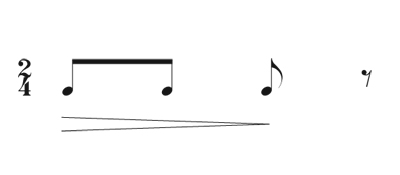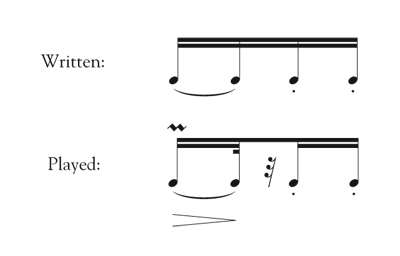When someone plays, the first thing you hear is the beginning of the note or the attack. Most musicians don’t like the word attack as it implies a certain amount of force which may or may not be needed to start the note as indicated in the music.
The Simple Attack
Without the instrument, have the flutist take a breath. With the lips closed, have the student begin to blow a small amount of air (like blowing to cool a hot beverage) to let the air stream naturally open and form the aperture. Maintaining this natural aperture, have the flutist place the tongue in the aperture. Without moving the embouchure or tongue, the student should breathe in through the nose and then pull the tongue back in a horizontal motion and release the air through the aperture. Simply, the tongue releases the air. The teeth are separated, and the tongue goes through the teeth to reach the lips. Repeat using the headjoint or assembled flute. Once this skill is mastered, check the pitch of the attack with the tuner. There should be very little, if any, movement towards the sharp side of the pitch. This is the reason that many professional flutists use this type of tonguing to begin a phrase. Some flutists use this approach for all tonguing situations.
There should be no movement in the lips when tonguing. If there is motion, then the tongue’s movement is too forceful. The movement of the tip of the tongue should be clear and rhythmic. There should also be no movement of the jaw when tonguing. The tongue can and should move independently. Use an anatomy book to study the relationship of the jaw and tongue. Often a picture is truly worth a thousand words.
To accurately play repeated tongued notes, the embouchure plate must be firmly placed in the chin. If the flute is moving or bouncing in the chin, it is difficult to direct the air column to the same place on the embouchure wall each time the tongue releases the air. The left index finger and the right thumb maintain this steady position. Placing the right hand on the barrel to pull the flute into the chin is a good practice technique for the notes that can be played with only the left-hand fingerings.
Once single notes can be played with this method, practice three notes followed by a rest on each note of a scale. To play musically, the first note will be the strongest (beat 1) and the third note, the softest (beat 2).

For most flutists, developing this type of attack will take many repetitions until it becomes a habit. Practice tonguing on the same pitch for a while before embarking on scales where each articulation movement is on a different note. I did not learn to tongue this way and switched as an adult because I wanted to improve the quality of the beginning of the note and correct the intonation (sharpness) at the onset of the note. Patience or repetition was the key as it took me about six months to completely switch over.
Breath or Hah Attack
Teachers often get students who only use the breath attack. This happens because it is difficult in a band classroom situation to be sure that each student is tonguing properly. Months may go by before someone notices that a student is not using the tongue. On the positive side, students who have only used the breath or Hah attack, usually have nice sounds. This happens because the Hah attack separates the vocal folds (opens throat).
Many passages in the solo and orchestral literature sound better when a flutist uses the breath attack. For example, Claude Debussy’s Prélude à l’après-midi d’un faune can be quite successfully begun with the Hah attack. Once again, the benefits from the Hah attack include a clarity of attack and improved intonation.
Multiple Tonguing
Double- and triple-tonguing strokes are placed as far forward in the mouth as possible. For the back or secondary stroke use the word key. For the key stroke, think of the word dental. The combined strokes (thi and key) happen first in front of the teeth and then slightly behind the front teeth. Years ago, when the da-ga or du-gu was in style, the back stroke was placed quite far back in the mouth. Unfortunately, this distance between the da in the front and the ga in the back took too much time to execute, so tonguing sounded slow and laborious. Often flutists complained of the tongue becoming tired. With a thi-key stroke, the tongue is basically fluttering in the air stream at the front of the mouth. The thi or key interrupts the air stream just enough to stop the air for the attack. As with most technical matters, working in chunks provides the quickest results so practice TKTK, T rest many times on notes throughout the range. Most people have a tendency to play these five notes unevenly making a larger space of time between the first sixteenth and the second sixteenth. Great results will occur when you rush the second sixteenth, placing it closer to the first sixteenth. Actually, this is playing exactly in time in most cases. Practicing with a metronome ticking on all the sixteenths will improve this skill.
For triple-tonguing, TKT, TKT is preferable to TKT, KTK because of the rhythmic implications of the meter and rhythm. However, practicing this technique has excellent ramifications for developing an even transition between the two consonants.
P or B Attack
If you are having difficulty making the aperture in the lips smaller, practicing P or B attacks (where the lips begin closed) is an excellent exercise to develop this skill. Many entrances that begin p, pp, or ppp in the top octave are best played with a P or B attack.
Tonguing vs. Articulating
I often start a masterclass by asking, “What is the difference between tonguing and articulating?” Usually there is silence followed by someone asking, “But, aren’t they the same?” Of course, the answer is that they are not the same. Tonguing is what flutists call the motion to use when looking at a passage and determining where to tongue and where not to based on the use of slurs. Articulating is putting life and energy into this motion to bring the passage to life. Most often this is accomplished by the increasing the speed of the air and the use of articulatory silences. Articulation is the goal.
In the following example, the key to playing this common articulation pattern lies in the definition of the word staccato. Staccato means detached, not just short. That means there must be silence before and after the note. The silence before a staccato note means the note before the staccato is shortened.

The next thing to consider is the two-note slur. Since the Renaissance (1450-1600) and certainly the Baroque (1600-1750), a two-note slur is played strong/weak or loud/soft. So, the first note is strong, and the second note is weak and shorter. The two staccato notes are played detached which means that they do not touch but have silence between them. Adding a smidge of color vibrato on the first note of a slur adds excitement, interest, and energy to a note. Think of color vibrato as a mordent of vibrato (faster). Once the passage has been executed this way, the distinction between tonguing and articulating becomes obvious.
Articulation Problems
Usually where there is a problem, the issue lies not with the tongue, but with the air stream. Practice all tongued passages slurred first and then repeat tonguing on the air. To demonstrate this, have students play off-beats (1 play, 2 play, 3 play, 4 play). Notice how the quality of the attack and the note is much better than when playing on the beat. I think when playing off-beats, which is something flutists do much less often than playing on the beat, they prepare the air better than when playing on the beat. Adding playing off-beats into daily practice sessions for several weeks offers excellent benefits.
When working with any skill, recording, listening back, and evaluation is important. A recorder that can be played back at half speed amplifies the attack issues quickly and honestly – sometimes a bit too honestly!






